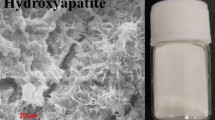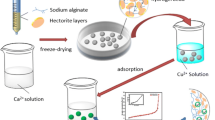Abstract
Removal of heavy metals from aqueous solutions has attracted much attention worldwide. Many processes and technologies have been developed to remove heavy metals ions. In our previous study, a silica-poly acrylic amphoteric hybrid hydrogel was successfully prepared with double-network (DN) structure using γ-aminoporpyltriethoxysilane as precursor through a two-step sequential network formation technique. In the present research, the absorption behavior of this hydrogel was investigated carefully using Cu2+ ions and Cr2O 2−7 ions as representatives of negative and positive ions respectively. Under different adsorption conditions, the adsorption behaviors of the hydrogel were studied in detail, including initial concentration of the adsorbed ions, adsorption time, pH and ionic strength. The results showed the absorption capacity to Cu2+ can reach 700 mg/g with an initial Cu2+ concentration of 1,200 mg/L within 2 h. The experimental results show that the Freundlich adsorption law is applicable to the adsorption of Cu2+ and Cr2O 2−7 on the hydrogel.





Similar content being viewed by others

References
Tang L, Liu W, Liu G (2010) High-strength hydrogels with integrated functions of H-bonding and thermoresponsive surface-mediated reverse transfection and cell detachment. Adv Mater 22:2652–2656
Wu J, Ge Q, Mather PT (2010) PEG-POSS multiblock polyurethanes: synthesis, characterization, and hydrogel formation. Macromolecules 43:7637–7649
Shi J, Liu L, Liu X, Sun X, Cao S (2008) Inorganic-organic hybrid alginate beads with LCST near human body temperature for sustained dual–sensitive drug delivery. Polym Adv Technol 19:1467–1473
Sahiner N (2007) Colloidal nanocomposite hydrogel particles. Colloid Polym Sci 285:413–421
Zhu X, Jiang X, Cheng S, Wang K, Mao S, Fan L-J (2010) Preparation of high strength ultrafine polyvinyl chloride fibrous membrane and its adsorption of cationic dye. J Polym Res 17:769–777
Zou H, Wu S, Shen J (2008) Polymer/silica nanocomposites: preparation, characterization, properties, and applications. Chem Rev 108:3893–3957
Yang J, Wang X, Xie X (2012) In situ synthesis of poly(acrylic acid) physical hydrogels from silica nanoparticles. Soft Matter 8:1058–1063
Fei X, Xu S, Feng S, Lin J, Lin J, Shi X, Wang J (2011) Mechanically strengthened double network composite hydrogels with high water content: a preliminary study. J Polym Res 18:1131–1136
Shi X, Xu S, Lin J, Feng S, Wang J (2009) Synthesis of SiO(2)-polyacrylic acid hybrid hydrogel with high mechanical properties and salt tolerance using sodium silicate precursor through sol-gel process. Mater Lett 63:527–529
Johnson JA, Turro NJ, Koberstein JT, Mark JE (2010) Some hydrogels having novel molecular structures. Prog Polym Sci 35:332–337
Karino T, Okumura Y, Zhao CM, Kataoka T, Ito K, Shibayama M (2005) SANS studies on deformation mechanism of slide-ring gel. Macromolecules 38:6161–6167
Seiffert S, Sprakel J (2012) Physical chemistry of supramolecular polymer networks. Chem Soc Rev 41:909–930
Tai Y, Watanabe M, Kaneko K, Tanemura S, Miki T, Murakami J, Tajiri K (2001) Preparation of gold cluster/silica nanocomposite aerogel via spontaneous wet-gel formation. Adv Mater 13:1611–1614
Kawaguchi M, Fukushima T, Hayakawa T, Nakashima N, Inoue Y, Takeda S, Okamura K, Taniguchi K (2006) Preparation of carbon nanotube-alginate nanocomposite gel for tissue engineering. Dent Mater J 25:719–725
Huang T, Xu H, Jiao K, Zhu L, Brown HR, Wang H (2007) A novel hydrogel with high mechanical strength: a macromolecular microsphere composite hydrogel. Adv Mater 19:1622–1626
El-Hag Ali A, Shawky HA, Abd El Rehim HA, Hegazy EA (2003) Synthesis and characterization of PVP/AAc copolymer hydrogel and its applications in the removal of heavy metals from aqueous solution. Eur Polym J 39:2337–2344
Bajpai SK, Johnson S (2005) Superabsorbent hydrogels for removal of divalent toxic ions. Part I: synthesis and swelling characterization. React Funct Polym 62:271–283
Takahashi A, Nagasawa M (1964) Excluded volume of polyelectrolyte in salt solutions. J Am Chem Soc 86:5543–5548
Ören S, Çaykara T, Kantoglu Ö, Güven O (2000) Effect of pH, ionic strength, and temperature on uranyl ion adsorption by poly(N-vinyl 2-pyrrolidone-g-tartaric acid) hydrogels. J Appl Polym Sci 78:2219–2226
Ceylan D, Okay O (2007) Macroporous polyisobutylene gels: a novel tough organogel with superfast responsivity. Macromolecules 40:8742–8749
Dubey A, Shiwani S (2012) Adsorption of lead using a new green material obtained from Portulaca plant. Int J Environ Sci Technol 9:15–20
Bayramoglu G, Arica MY (2011) Preparation of a composite biosorbent using scenedesmus quadricauda biomass and alginate/polyvinyl alcohol for removal of Cu(II) and Cd(II) ions: isotherms, kinetics, and thermodynamic studies. Water Air Soil Pollut 221:391–403
Baskaralingam P, Pulikesi M, Elango D, Ramamurthi V, Sivanesan S (2006) Adsorption of acid dye onto organobentonite. J Hazard Mater 128:138–144
Acknowledgement
This work was supported by the National Natural Science Foundation of China (50763005), the Startup Foundation for Doctors of Xinjiang University, China (BS090119), and National University Student Innovation Program of China (101075505).
Author information
Authors and Affiliations
Corresponding author
Rights and permissions
About this article
Cite this article
Fei, C., Huang, D. & Feng, S. Adsorption behavior of amphoteric double-network hydrogel based on poly(acrylic acid) and silica gel. J Polym Res 19, 9929 (2012). https://doi.org/10.1007/s10965-012-9929-y
Received:
Accepted:
Published:
DOI: https://doi.org/10.1007/s10965-012-9929-y



